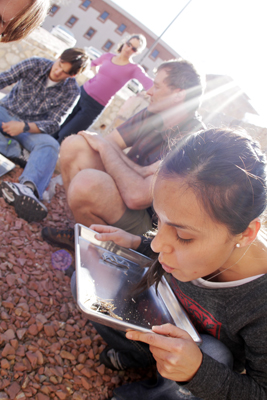By Daniel Perez
UTEP News Service
UTEP doctoral student Sergio Vargas marked a small cotton ball with a lip balm and then used a flint and steel to set it ablaze outside the Bioscience Research Building as part of survival training for an upcoming arctic research trip.
Vargas was one of seven students, including one undergraduate, who attended the two-day Arctic Field Training last week offered by instructors from Denver-based CH2M Hill Polar Services (CPS). Along with fire starting, the students learned about water purification, best methods to stay warm and dry, how to pitch a tent, and ways to deter interest from three varieties of bears.
“The information has given me more confidence in how to avoid bad situations,” said Vargas, an environmental science student who will make his fifth trip to the Great White North. “It’s stuff that’s handy to know.”
The students will venture to Barrow, Alaska, to study the impact of climate change on the ecosystem, map changes to historic research sites, and use new techniques to measure changes to vegetation. The temperatures will be around freezing for most of the three-month journey that starts at the end of May.
The trip will be led by Vanessa Lougheed, Ph.D., and Craig Tweedie, Ph.D., associate professors of biological science at UTEP and the principal investigators on several active grants that UTEP has in the Arctic.
Both would give an informal safety presentation to their arctic-bound students, but decided to invite the CPS team to share additional tactics that would help the students if they became lost or injured in a cold environment.
“This special safety training is a refresher (course) for some of them, but it’s valuable,” Lougheed said while the students practiced setting the cotton balls on fire.
The day’s instruction was lead by Allen O’Bannon and Iris Saxer. O’Bannon discussed and demonstrated different ways to start a fire and purify water, and shared his thoughts on various helpful items to keep in a simple first-aid/emergency kit.
After the class was dismissed, O’Bannon said there is growing interest in the type of advice the CPS shares with National Science Foundation-funded researchers. Two years ago, the company offered one class to 20 people at its headquarters. Last year – the first time it traveled to offer classes – it had more than 100 students. He expects to exceed that this year as he teaches from coast to coast and border to border.
“I enjoy teaching this stuff. The information we share is helpful to researchers, so they are interested in learning what we have to say,” said O’Bannon, who spent 20 years with the National Outdoor Leadership School in Lander, Wyo.
As for his advice on bears, he suggested researchers keep an eye out for them, try to avoid contact if possible, and be prepared with bear spray (mace) and a firearm. He said that 97 percent of the time a bear will be deterred by the spray. He said firearms are only 60 percent effective.
“Unless you kill the bear, things don’t go well for that other 40 percent,” he said.
